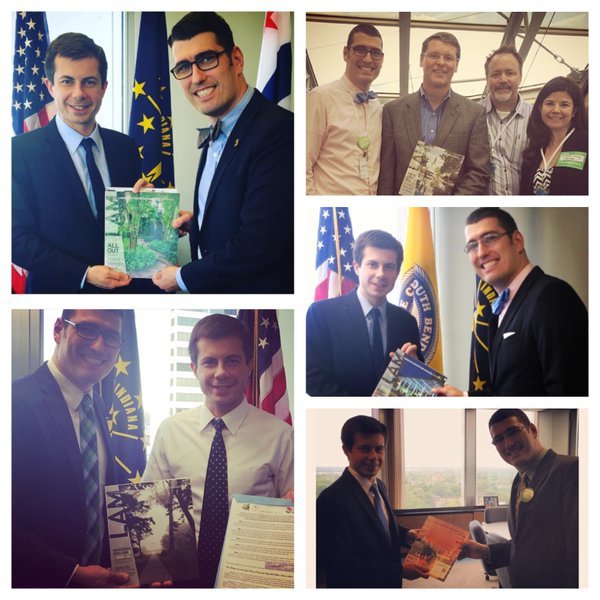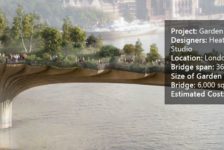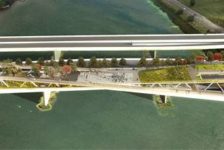“When people think about what influences elected officials, nine times out of ten their first thought is money… Clearly, skepticism reigns supreme when it comes to our views of how to influence a policymaker.” – Stephanie Vance, “Citizens in Action”
Despite being “for the people, by the people,” our representative democracy can seem distant. It can appear inaccessible and elitist, particularly when sensationalized by the “yellow journalism” of contemporary news media. Lobbying, and by extension advocacy, further brings to mind a hidden element of governance. Because of that, they are both practically four letter words. While this presidential election cycle has brought to the forefront the concept of politicians being “bought” by powerful lobbies, simply viewing government as a trade deal undermines the value of advocacy and professional lobbying.
I attended my first ASLA Advocacy Summit with a similar perspective and with a far greater understanding of the concurrent Awareness Summit. At the same time, I approached the event both grateful for being there and committed to gleaming every ounce of value out of the experience for the chapter I represented*. Of the dual arms of chapter outreach, Awareness (Public Relations) is sexy and glam; who doesn’t want their picture on television? Advocacy, because of the distance of government, lacks the same initial luster. Even as I listened to a professional lobbyist describe the services that he offered the society, I still had misgivings. As he outlined case studies in landscape architecture licensure battles that had littered the ground of advocacy for the society in recent years, I was unconvinced. In a state that seemingly had a shield to any licensure attacks – Indiana has a combined board with the architects who were not likely to come under any sunset issues – it was hard to reconcile the cost of lobbying. Despite the need for vigilance, the issue of licensure did not have the same sense of urgency in my state as with other chapters. Without the urgency, advocacy remained a back-burner issue, especially compared to the draw of World Landscape Architecture Month or the need for continuing education credits and networking value of the state’s Annual Meeting.
As the presenter shifted to outline the tangent benefits of advocacy and lobbying, one line was burned into my mind: “Raising the profile of the profession.” That even without a specific “ask” or dramatic need, landscape architects would benefit from engaging policymakers if for no other reason than to make the profession more prominent in the eyes of those individuals who controlled much of the direction of the built environment through the allocation of funds or the implementation of guiding policies. This was a seminal moment for me and one that changed the way that I viewed professional practice. I began to see advocacy as a partner to awareness and public relations. At the same time, I began to view Government Affairs as the natural progression in the pursuit to work as a landscape architect. It’s a complicated feeling to watch the built environment evolve, knowing that your own involvement could improve the quality of place or positively contribute to changing public health, safety, and welfare. This was a moment of clarity, like Neo seeing the Matrix for the first time. Everything was different. I was already aware of the problems that plague the profession – lack of understanding, vague licensure laws, engineering bias; finding problems to solve is easy. Inherently, landscape architects also know that layering in solutions to the problems would produce systemic benefit. But it was through advocacy to local, state, and federal policymakers that landscape architects would have the opportunity to be a constant part of the conversation. Through better advocacy, landscape architecture can become a baseline expectation, not just an add-on or luxury component or easy to value-engineer out.
That process is not an easy path to follow. There are a landslide of different things competing for a policymaker’s consideration: events, meetings, votes, and interactions with constituents. At every level of government attention is sought to prioritize the perspective of the advocate. For most policymakers, a simple trip to the grocery store results in being accosted on issues that range from celebrating cats to trade agreements. While fellow landscape architects may have clarity of purpose in our collective professional practice, it does not mean that precise understanding is shared. The question becomes how does ASLA approach Government Affairs in a way that contributes to the success of the profession? How do landscape architects break through the noise and connect with the issues the policymaker values? Three key components address those questions and comprise the mission of ASLA’s Government Affairs arm: 1) Clarity of message, 2) Constant vigilance of the legislation, and 3) Consistent interaction with policymakers at every level of government.
While specific legislative “asks” may vary year to year based on need, ASLA has 5 primary advocacy focus areas: Water and Stormwater Management, Transportation Planning and Design, Community Design and Development, Small Business Growth and Development, and Licensure. These are determined through annual surveys on the most pressing issues of the profession given to the general membership, chapter leaders, and ASLA staff. Personal politics have no place when advocating on behalf of ASLA, but personal stories communicating the value and providing specific examples of the focus areas add depth and legitimacy to otherwise constant din of issue promotion. Bonus points if the examples are in the district of the policymaker.
Advocacy is not for the faint of heart. Thousands of bills pursue legislative action each year, even locally, and that translates to a significant investment in time to be aware of any issue that may impact the profession**. Even worse, if Tracking Legislation sounds as exciting as reading your city’s Code of Ordinances, it’s because it is. The language is often legalese and not everything is a clear-cut as the recent “Roads Not Roses” fiasco, which was aimed at “repealing the authority of the Secretary of Transportation to approve as part of the construction of federal-aid highways the costs of landscape and roadside development” and a major talking point in this year’s Advocacy Day. However, it’s in the minutia that so many attacks on ASLA’s legislative focus areas come to gain ground (see ASLA’s Legislative Tracking here).
Even with a clear message and staying on top of important votes and rulings, without continuing to follow-up with policymakers, the value diminishes. This means not only interacting when something is needed, but ensuring that landscape architects can be seen as a resource by connecting our issues to the ones policymakers are already engaged in. ASLA gives chapters a myriad of tools to execute local and state advocacy pushes. While time commitment to stay fully engaged in government affairs is one key reason to hire a chapter lobbyist (especially with the previously mentioned drove of proposed legislation), members must consistently interact with policymakers for the value of our message to be understood. At the federal level, ASLA hosts Advocacy Day each year for chapter leaders to engage House and Senate representatives on Capitol Hill. This event is held in conjunction with the Chapter Presidents Council midyear meetings. At the state and local level, each chapter is encouraged to hold tours with elected officials or host state lobby days, with resources available to organize each.
Once the value of advocacy is understood, it is a short jump to view every component of ASLA through the lens of Advocacy. For me, this includes issues from governance to marketing and communication. Why should you be a member of ASLA? To better facilitate government affairs. Why should bylaws be updated to have longer term limits for leadership positions? So that leaders can be both better informed and more comfortable in their roles in societal advocacy. What should public relations and awareness efforts focus on? The same issues we highlight in our government advocacy campaigns. How do we stem the tide of additional licensure battles? Through more robust advocacy. It is that important. Like many aspects of ASLA, the more involved you get with the society, the more value you see in participating. Advocacy is no different.
Ultimately, if all designers share the professional goal to do the best work possible, then we must change the system, raise the minimum design standards, improve the policies that guide and shape the built environment, and allocate the resources to have the greatest impact. If all we have to design to is the minimum standard, then we are destined for a society of mediocrity and continued environmentally catastrophe. But if we take our oath of stewardship seriously and embrace the declarations of the next generation of landscape architecture we have to do more. To do this work successfully, we must advocate at every level of government with clarity, consistency, and insight.
- For more information, including how to contact your legislators, visit: http://advocate.asla.org/
- Or watch the ASLA iAdvocate Video
- Photos provided by Jonathon Geels and via Jared Green from Advocacy Day 2016; Declaration of Independence painting by John Trumbull can be found at the Architect of the Capitol website
- *I live tweeted each of the Advocacy Summits I’ve attended and you can read the highlights by checking out my twitter feed: @JonathonGeels
- **Legislative action from the 2016 Indiana General Assembly: https://iga.in.gov/legislative/2016/bills/;
—
Jonathon Geels enjoys solving problems by connecting people to new ideas through design, innovation, and advocacy. He is passionate about improving public health, the built environment, social equality, as well as resource management and hopes to engage other professionals with the same enthusiasm.












